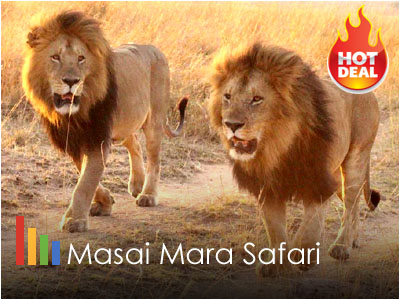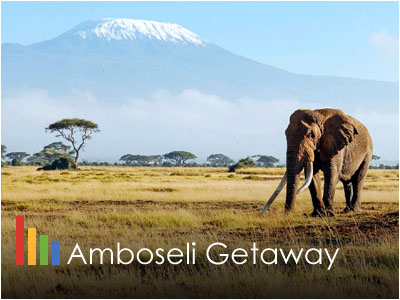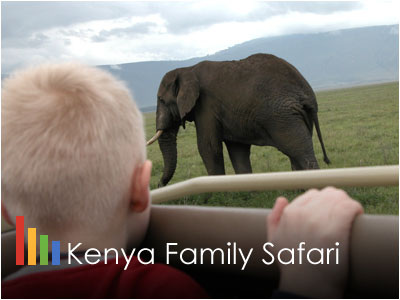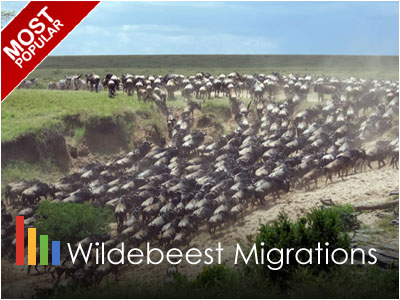Masai Mara National Reserve, Kenya, Africa
Masai Mara National Reseve - Kenya, Africa
Masai Mara National Reserve is one of the most popular tourism destinations in Kenya- Africa. Masai Mara Game Reserve reserve is located in the Great Rift Valley in primarily open grassland. Wildlife tends to be most concentrated on the reserve’s western escarpment. The Masai Mara is regarded as the jewel of Kenya’s wildlife viewing areas. The annual wildebeest’s migration alone involves over 1.5 million animals arriving in July and departing in November. There have been some 95 species of mammals, amphibians and reptiles and over 400 birds species recorded on the reserve. Nowhere in Africa is wildlife more abundant, and it is for this reason a visitor hardly misses to see the big five i.e. buffalo, elephant, leopard, lion, and rhino...

Basic Facts - Masai Mara National Reserve
Masai Mara Game Reserve measures approximately 1,672 sq kms. This world-famous wildlife sanctuary is located in Narok County, Kenya, East Africa at th e South - Western Kenya bordering Serengeti National Park, on the Tanzania border. It is situateed between 1,500-2,170m above sea level. In the dry season (July-October) the reserve is a major concentration area of migratory herbivores including approximately 250,000 zebra and 1.3 million wildebeest. There are also gazelle, elephant, topi, buffalo, lion (Kenya's largest population), black rhino, hippo, hyena, giraffe, leopard, and cheetah. Typically, its terrain features grasslands with patches of acacia woodland, thickets, and riverine forests and rolling plains. The birdlife: Prolific, including 53 birds of prey. Visitor Facilities include several luxury and budget safari lodges and campsites.
More About Masai Mara National Reserve
The Masai Mara Game Reserve is one of the best known and most admired reserves in the whole of Africa. The Masai Mara lies in the Great Rift Valley, which is a fault line some 3,500 miles (5,600km) long, from Ethiopia's Red Sea through Kenya, Tanzania, Malawi and into Mozambique. Seasoned safari travellers, travel writers, documentary makers and researchers often admit that the Masai Mara is one of their preferred places. The reason is perhaps it is because of its 'big skies', the open savannahs, the romance of films like 'Out of Africa' and certainly because of the yearly wildebeest migration, the concentration of game, the diversity of birdlife and the excellent opportunity of taking a hot air balloon ride! Maasai Mara Game Reserve, is widely considered to be Africa's (and probably world's) greatest wildlife reserve. The Mara comprises 200 sq miles of open plains, woodlands and riverine forest. Adjoining the plains of the Serengeti, the Mara is home to a breathtaking array of life.
The immense grassland plains are scattered with herds of Zebra, Giraffe, Gazelle, and Topi. The Acacia forests abound with Birdlife and Monkeys. Elephants and Buffalo wallow in the wide Musiara Swamp. The Mara and Talek rivers are brimming with Hippos and Crocodiles.Each year the Masai Mara plays host to the world's greatest natural spectacle, the Great Wildebeest Migration from the Serengeti. From July to October, the promise of rain and fresh life giving grass in the north brings more than 1.3 million Wildebeest together into a single enormous herd. They pour across the border into the Mara, making a stunning entrance in a surging column of life that stretches from horizon to horizon.The first sight of the Masai Mara Game Reserve is breathtaking. Here the great herds of shuffling elephants browse among the rich tree-studded grasslands with an occasional sighting of a solitary and ill-tempered rhino, Thompson's and Grant's gazelle, topi and eland and many more species of plains' game offer a rich choice of food for the dominant predators; lion, leopard and cheetah which hunt in this pristine wilderness.
Every year staring from the early July to late September, over a million Gnus (wildebeests) and Zebras followed by the big cats cross over the rolling plains of the Masai Mara setting the most spectacular marvel of mother nature that cannot be witnessed in any other part of the world. This undoubtedly becomes the best times to visit Africa. The sight of the mass migration is truly awesome. As the migration unfolds, the wildebeest, zebra and gazelle are trailed by the predators- lion, leopard, cheetah, and hyena and scavenger birds. The vast, open grasslands of the Serengeti-Mara are home to over 3 million large mammals. These include over 1.4 million wildebeest, which migrate in an enormous, straggling herd each year between the southern part of the Serengeti to the northern part and back again. With them move other herbivores such as gazelles and zebra, also looking for the best grass. Along the way they provide food for big predators such as lions, leopards and cheetahs.

On a single visit to Masai Mara, you see first hand the intricate web of dependency that binds the different species together. Each animal has adapted to its own niche and to the other animals that surround it. Here we see Nature at its most subtle and, sometimes, most cruel as each animal struggles to survive and reproduce. On our morning and afternoon game drives in the Masai Mara we have a very good chance of seeing all the major Plains animals including lion, leopard, buffalo, elephant, rhino, hyena, cheetah, jackal, warthog and many species of antelope. It is a natural spectacle that nature lovers cannot afford to miss. Masai Mara is also the land of Big Cat Diary and Disney’s African Cats and location of one of the natural wonders of the world, the Great Migration, the Maasai Mara is at the top of most people’s wish lists on a Kenya safari holiday. The Masai Mara is a gloriously beautiful, wildlife-rich savannah landscape, where traditionally dressed Maasai pastoralists herd their cattle and goats. It’s also where herds of minibuses jostle for the best photo opportunity amid a panorama of African wildlife. For more information regarding Wildebeest Migration Safaris, DO NOT hesitate to Contact Us.
The Masai Mara region is comprised not only of the Masai Mara National Reserve (the original, state-run park) but of a vast area to the north of the Reserve, and for many years now, some of this has been set aside for wildlife and conservation of the habitat adjacent to the Mara Resreve. These are private areas of pristine wilderness with strict controls on the number of visitors and vehicles permitted. In each Conservancy there are normally just a handful of small safari camps with their guests gaining exclusive access to thousands of hectares of prime game-viewing land. Nature doesn’t recognise borders and as a result the Mara conservancies have provided an additional area of sanctuary for many animals wishing to disperse beyond the National Reserve where there may be higher volumes of tourists and safari vehicle traffic especially in the peak season months. Guests staying on the conservancies also benefit from additional activities not allowed in the main Reserve such as guided safari walks, off road driving with experienced driver-guides, meals in the bush and night game drives to observe the area’s nocturnal species. For more information regarding this topic, DO NOT hesitate to Contact Us.
The climate in Masai Mara is gentle, rarely too hot and well spread rainfall year round. When it rains, its is almost always in the late afternoon or night. Between July and October, when the great wildebeest migration is in the Mara the sensation is unparalleled. The wildlife is far from being confined within the Reserve boundaries and an even larger area, generally refered to as 'the dispersal area' extends north and east of the game Reserve. Maasai live within the dispersal area with their stock but centuries of close association with the wildllife has resulted in an almost symbiotic relationship where wildlife and people live in peace with one another. July to October is dry and the grass is long and lush after the rains. This is the best time to come and see the huge herds of migratory herbivores. Early bookings are recommended to avoid last minute dissapointment as hotels are normally full in this season.
The main route into the Masai Mara Game Reserve is via Narok, on the main B3 road which leaves the old Nairobi - Naivasha road at Maai-mahiu. At Ewaso Ngiro, 15 kms beyond Narok, are a crossroads where the left branch forms the C12 to Keekorok via Sekenani Gate, tarred for a further 40 kms.The right branch forms the B3/C13 to Kichwa Tembo Lodge and Oloololo Gate. At Aitong, another track (the E177) branches off towards Keekorok via Talek Gate. It is also possible to approach the park from Migori (on the main A1 Kisii - Tanzania road) via Lolgorien. The last section of this route is very steep and the road is seldom used. When driving in the park remember that only two bridges cross the Mara River which effectively divides the park into two: the northern Mara River bridge is near Kichwa Tembo lodge; the southern Mara bridge is on the E176 main park track between Oloololo Gate and Keekorok. In terms of public transport, buses from Nairobi go as far as Narok, and private transport from there will have to be arranged. Arriving from the west, there are occasional buses to Lolgorien from Migori or Kisii.
There are many lodging options in and around Masai Mara National Reserve. In the reserve itself, options include: the Mara Sarova Camp with 150 beds; the Mara Sopa Lodge with 144 beds; the Mara Serena Lodge with 152 beds; the Keekorok Lodge with 158 beds; Governor's Camp with 76 beds; Little Governor's Camp with 34 beds; and the Mara Intrepids Club 'with 60 beds. On the periphery of the Reserve, lodging includes: the Fig Tree Camp with 140 beds; the Kichwa Tembo Camp with 102 beds; Sekanani Camp with 30 beds; Lodging located in the game dispersal areas include: the Mara Safari Club with 80 beds; the Mpata Safari Club with 20 cottages; the Siana Springs Camp with 76 beds; and the David Livingstone Lodge with 156 beds. Over 20 campsites are located in the Masai Mara Reserve area, but no single map produced by the Reserve or elsewhere marks them all.
Officially, all campsite reservations have to made at the Parks headquarters in Narok, but in practice you can arrive at any public site without prior booking. A non-exhaustive list of the campsites in and around the reserve include: Crocodile Camp, a private campsite just outside the reserve; the Oloololo Gate Campsite near the gate of the same name; the Mara Serena Lodge Campsite, located west of the Mara River near the lodge; the Talek River Campsites (10 of them), near the Talek River just outside of the Reserve boundary; the Mara River Campsites (4 of them), in a Masaai concession outside the Reserve; the Musiara Gate Campsite, next to the gate of the same name; the Talek Gate Campsite on the nort bank of the Talek River; the Sekenani Gate Campsites (4), about 0.5 kms before the Gate; the Naunerri Campsite, 3 kms from Sand River Gate; the Sand River Gate Campsite; and the Fig Tree Campsite, west of the Talek Gate Campsite. More new campsites continue to come up in Masai Mara Game Reserve.
AfriChoice operates a wide range of carefully designed tours and safaris to Masai Mara Game Reserve by providing transport and booking a hotel for you. Our safari consultants will always be at your assistance should you need a tailor-made holiday to this unique destination. NB: For more information regarding this topic, DO NOT hesitate to Contact Us.
Contact Us for more information:
Kenya Popular Wildlife Safaris
-
Masai Mara Escapade
3 Days / 2 Nights Safari
-
Amboseli Safari Getaway
3 Days / 2 Nights Safari
-
Kenya Highlights Safari
5 Days / 4 Nights Safari
-
Best of Kenya Safari
8 Days / 7 Nights
-
Kenya Family Wildlife Safari
10 Days / 9 Nights Kenya Safari
-
Wildebeest Migration Safari
10 Days / 9 Nights Migrations Safari
-
Kenya Wildlife Photo Safari
11 Days / 10 Nights Photo Safari
-
Kenya Safari & Beach Holiday
Kenya Safari & Beach Holiday



 Paul Kitching - UK
Paul Kitching - UK Karen Howard - CANADA
Karen Howard - CANADA









